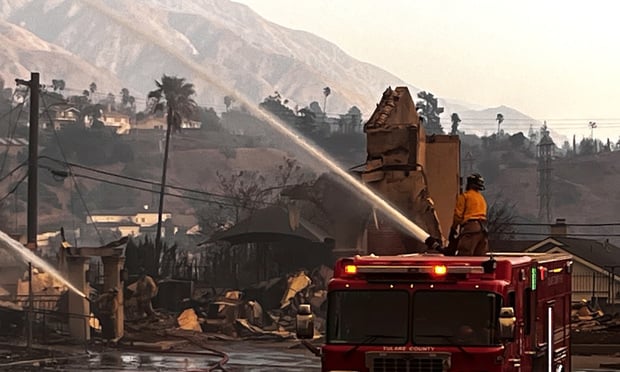 One typical sign of an insurance market in transition from soft to hard is the shift of certain risks from the admitted universe back to the specialty market.
One typical sign of an insurance market in transition from soft to hard is the shift of certain risks from the admitted universe back to the specialty market.
And according to some well-positioned industry sources, this is clearly starting to happen in lines such as high-risk property.
“Business that went to the standard market is now coming back,” Mark Lyons, CEO of specialty-insurer Arch Worldwide, asserted during a presentation on industry financials at Advisen's Property Insights Conference held in New York this month.
According to Lyons, admitted insurers are now getting rate increases on the insurance lines they know best and therefore can shed the risks “they weren't comfortable with anyway.”
“When standard carriers begin to see adverse [conditions for] the [specialty] business they took, they typically return to their core competency,” adds Richard Shaak, president and CEO of Starr Technical Risks and president of Starr Specialty Lines. “And we are definitely seeing this happening.”
W. Robert Berkley, president and chief operating officer of W.R. Berkley Corp., noted in April during the company's most recent quarterly earnings call that he, too, has seen a gradual increase in the flow of submissions to the specialty market.
IN THE (DANGER) ZONE
Of the account types being jettisoned by the admitted market, the one most commonly referenced is high-risk property.
MarketScout's Market Barometers for April and May 2012 both mention a retreat by admitted insurers in coastal areas as hurricane season blows in.
MarketScout CEO Richard Kerr notes many admitted markets are cutting back capacity or requiring higher deductibles in wind-exposed areas.
Chris Zoidis, vice president of the special-risk division at broker Burns & Wilcox, says admitted commercial-lines carriers “seem to be tightening underwriting guidelines around the fringes and nonrenewing accounts with a loss.”
Zoidis notes this is happening especially for properties in Protection Class 9 and 10 areas—the classification related to fire service in the area of the insured property (with 10 being no service).
For personal property, carriers have become less tolerant of claims when considering renewals, adds Zoidis. Additionally, carriers are retreating from business in mono-line homeowners' insurance in favor of more-profitable auto-insurance business.
“During the soft market, many were willing to stay with mono-line homeowners', but now we're seeing them abandon that,” Zoidis says. “If they can't get auto and home together, they'll drop the home even if it is a nice account.”
While some of this dropped business does end up with an admitted competitor, many nat ional and regional carriers have adopted the same strategy, Zoidis adds.
ional and regional carriers have adopted the same strategy, Zoidis adds.
THE MODEL IMPACT
Risk Management Solutions' (RMS) Version 11 U.S. hurricane model undoubtedly has also had some effect on the return of accounts to nonadmitted insurers. Zoidis says the model allows admitted carriers to reassess portfolios on a per-risk basis and identify those not performing well.
Joel Cavaness, president of Risk Placement Services Inc., a subsidiary of insurance-broker Arthur J. Gallagher, says RMS' model revision has had a “significant impact” on carriers' perception of coastal property.
“Some looked and said, 'Whoa! We have too much here,'” he says of carriers' coastal exposure. Most action thus far is in Texas, the Carolinas, New Jersey and New York, he adds.
At the American Association of Managing General Agents' annual meeting in May, Immediate Past President Mark Rothert noted during a presentation that RMS Version 11 has had an impact on the availability and affordability of reinsurance, which has driven some risks—some of which have been profitable for many years—to excess carriers.
THE EFFECT ON AGENTS
Zoidis says retail agents are so nervous about whether coverage renewals will even be made available that many of them are soliciting quotes from nonadmitted carriers as well, in order to make sure their clients will have some coverage options.
Cavaness notes that one upshot of this transition is that producers will find themselves having some difficult conversations with clients.
With the prolonged soft market now on its way out, many agents are no longer able to offer clients a low-priced option at renewal. “If you've been [at the same brokerage] for 10 years, you may never have had to deliver price increases,” he says.
With clients seeking Wind coverage in the Southeast, for example, agents will be forced to break the news of price increases of 10-15 percent or more, whether the quote originates from an admitted or nonadmitted carrier.
“We have been educating [agents], because they've never had to do it,” says Cavaness. “It's difficult to bring that to a client—something they may not expect or have budgeted for.”
Want to continue reading?
Become a Free PropertyCasualty360 Digital Reader
Your access to unlimited PropertyCasualty360 content isn’t changing.
Once you are an ALM digital member, you’ll receive:
- Breaking insurance news and analysis, on-site and via our newsletters and custom alerts
- Weekly Insurance Speak podcast featuring exclusive interviews with industry leaders
- Educational webcasts, white papers, and ebooks from industry thought leaders
- Critical converage of the employee benefits and financial advisory markets on our other ALM sites, BenefitsPRO and ThinkAdvisor
Already have an account? Sign In Now
© 2025 ALM Global, LLC, All Rights Reserved. Request academic re-use from www.copyright.com. All other uses, submit a request to [email protected]. For more information visit Asset & Logo Licensing.








